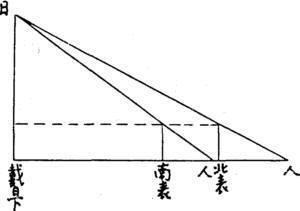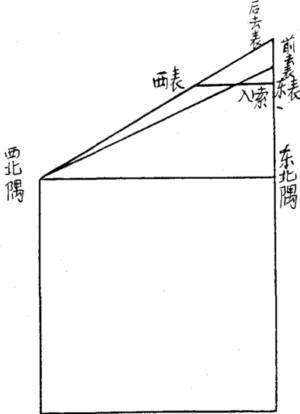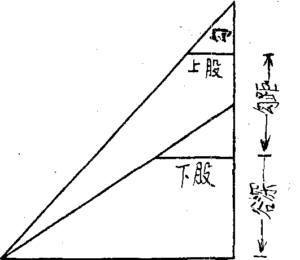Chapter 24 Heavy difference in the fifth quarter
The gravity difference method was developed from measuring the height of the sun.Liu An's "Huainanzi" in the Western Han Dynasty has the embryonic form of this method.Liu Hui believes that the observation objects in "Nine Chapters" are all side-to-side, not super-miao, such as the sun.He developed and perfected the weight difference technique, and pointed out in the "Nine Chapters of Arithmetic Notes" that "everyone who has a very high vision, who has measured the depth and knows the distance must use the weight difference, and the Pythagorean must use the weight difference as the rate."Summarize the formula for measuring the height and distance of the sun: set up two meters in the north-south direction on the flat land in Luoyang, with a height of 8 feet.Measure the shadows of the two tables at noon on the same day. The scenery and the surface are the truth, and the reality is as one as the law, that is, from Nanbiao to Nandai Sunset."That is: Rigao = (Table Height × Table Room) / Scenery Difference + Table Height, from Table to Dai Rixia = (South View × Table Room) / Scenery Difference.
Among them, "inter-table/scene difference" is the ratio of two differences, so it is called double difference technique, as shown in Figure 24.Dairixia is the point where the sun shines directly on the earth.These two formulas are based on the theory that the sky is round and the earth is flat, which is not realistic, but it is correct in mathematical theory. The first question in "Hai Dao Suan Jing" is to measure the altitude of an island. The method and formula are exactly the same as the above-mentioned Rigao technique, which is the so-called double table method.The island is 4 miles and 55 steps high, which is 1792.14 meters today (calculated with Wei Chi 23.8 cm), and it is 102 miles and 150 steps away from the observation point on the mainland, which is 43911 meters today.

Figure 24 Repeated table method
There are no such islands along the coast of China. The author believes that Liu Hui took Mount Tai (1536 meters) as the prototype and pretended to be an island so that it could become an object that cannot be seen from the side.Liu Hui once said: The round sky can be measured, "What's more, the height of Mount Tai and the vastness of the river and sea?" In fact, the above data are much more accurate than the records of the height of Mount Tai in historical records of all dynasties, and they are also more accurate than those recorded by scholars in the Qing Dynasty. The result of measuring with weight difference technique is much more accurate.

Figure 25 Link method
Lianso method is another main method of heavy difference technique. The third question in "Sea Island" is to look south to Fangyi, erect two tables, the same height as a person, 6 Zhang from east to west, and connect them with cables, so that the east table and the southeast and northeast corners of the city are in a straight line.Walk 5 steps north from Dongbiao, look at the northwest corner of the city, enter the east end of 2 feet 2 feet 61/2 inches, and walk 13 steps 2 feet north, just in line with Xibiao and the northwest corner of the city, ask Yi Fang What is the distance from Jibiao to the city?Figure 25.Liu Hui first seeks: Scenery difference = (Enter Suo × Later Qu Table)/Example Moment, then: Yi Fang = Ru Suo (Later Qu Table - Front Qu Table) / (Scenery Difference - Front Qu Table), Yi Qu Table = Front Qu Table (back to table - view difference) / (view difference - front to table)

Figure 26 cumulative moment method
The cumulative moment method is another main method of the heavy difference technique.The fourth question is to measure a deep valley, put the moment on the bank of the deep valley, the height of the hook is 6 feet, look at the bottom of the valley from the top of the hook, and go to the lower part of 9 feet 1 inch, then move the moment up 3 feet, from the top of the hook Looking at the bottom of the valley, the stock that enters the moment (called the upper stock) is 8 feet 5 inches. How deep is the valley?As shown in Figure 26, Liu Hui gave the formula: valley depth = hook moment × upper share/share difference - hook.
Liu Hui put forward: "Those with high degrees pay attention to the table, those who measure the depth accumulate moments, those who are isolated look three times, and those who are separated and seek sideways look around." In addition to the above-mentioned three questions that need to be tested twice, questions 2, 5, 6, and 8 need to be tested three times, and questions 7 and 9 need to be tested four times.China's heavy difference technique was prepared by Liu Hui. Later, Qin Jiushao and others made some improvements in the method of prediction, but in terms of mathematical theory, there were no new breakthroughs before the introduction of Western mathematics in the late Ming Dynasty.How these prognostic formulas were proved is unknown because Liu Hui's own annotations and diagrams have been lost, and later generations have discussed it a lot.Some people think that the principle of proportionality of the corresponding sides of similar Pythagorean shapes is used, and some people think that the principle of complementary areas is used. From the perspective of Chinese mathematical tradition and the level of mathematics at that time, both are possible.For complex issues, Liu Hui's annotations often use both.

Figure 24 Repeated table method

Figure 25 Link method

Figure 26 cumulative moment method
